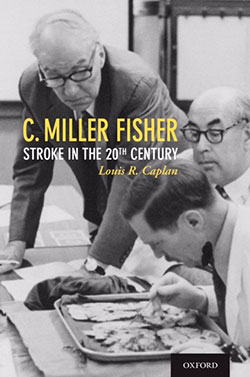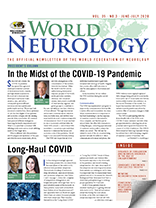by Louis R. Caplan, Oxford University Press 2020
by Vladimir Hachinski

Who was the greatest contributor to the field of stroke in the 20th century?” If you answer the question, you risk displeasing somebody somewhere with a different opinion. On being asked that question after a lecture in Moscow, I answered: “The greatest contributor to the understanding of the common causes of stroke is C. Miller Fisher.” Few would disagree. He established the relationship of carotid disease to ischemic stroke, characterized the clinical and pathological feature of lacunar syndromes, and proved that atrial fibrillation can cause stroke in the absence of cardiac valvular disease.
Lou Caplan is one of Miller Fisher’s most distinguished pupils and colleagues. He describes these and others of Miller Fisher’s contributions in historical context.
Carotid Disease
Hans Chiari in 1905 described the relationship of carotid stenosis to stroke. If the implications were ever appreciated, they were soon forgotten. Transient ischemic attacks (TIAs) were recognized, but most physicians accepted the explanation offered by the great Canadian/American/British physician William Osler, who attributed them to “vasospasm.” The explanation of vasospasm as a cause of TIAs proved plausible, convenient, and wrong. Miller Fisher observed the transient platelets and other materials through the retinal arteries during a TIA and concluded that embolism from the extracranial arteries was the common cause of TIAs. It was MiIler Fisher who established that carotid disease could lead to stroke and laid the scientific bases for carotid endarterectomy.
Lacunar Syndromes
Miller Fisher described five classical lacunar syndromes based on extensive clinical observations and meticulous brain dissections. As atherosclerotic large vessel disease decreases with better treatment, small vessel disease gains greater prominence.
Atrial Fibrillation
When Miller Fisher began his career, atrial fibrillation as part of rheumatic heart disease was recognized as being associated with stroke, but not as a cause by itself. In 1977 he published a study that left no doubt that atrial fibrillation by itself could cause stroke though cardiac embolism. Even before his definitive study, he had been advocating prophylactic anticoagulation in atrial fibrillation, still the mainstay of prevention.
Caplan’s own clear writing is enhanced by quotes from Miller Fisher’s detailed memoirs spanning a long life. The main headings make for easy reading and scanning.
Caplan’s direct knowledge of the field, of the main players and his own contributions allow him to state: “This book is also in many ways a biography of a disease (stroke) as it evolved during the 20th century.” This is not to deny the contribution of others, as Caplan has documented himself in his co-edited book on stroke syndromes, nor the fact that advances in the field increasingly are made by contributions from all around the world.
Caplan manages to convey a sense of the times and how a field dominated by therapeutic nihilism became one of a growing array of treatments and interventions. Caplan’s scene-setting illustrated by Miller Fisher’s own words also convey a sense of the man: Miller Fisher as a doctor, naval officer, survivor of a torpedoed ship, prisoner, prison physician, neurologist, neuropathologist, teacher, mentor, and thought leader. He, along with his many pupils and the pupils of pupils, has played a major role in transforming the field. These include Robert Ackerman, Lou Caplan, Steven Cramer, Stephen Davis, Geoffrey Donnan, Phillip Kissler, Walter Koroshetz, JP Mohr, Alan Ropper, Martin Samuels, and Philip Wolf, among many others.
Seldom has a medical story been told so well, so credibly, and so accurately by someone who has been a partner and participant in the advances that he describes. It is a delight to read by anyone with a health sciences background, and a must for those in the field of stroke. George Santayana wrote, “Those who cannot remember the past are condemned to repeat it.” We do want all those involved in stroke to remember the past, so that we can have many repeats of Miller Fisher’s inspiring example in the multiplying subfields of stroke.
Vladimir Hachinski, MD DSc is Distinguished University Professor, University of Western Ontario London, Canada, and a past president of the WFN.
